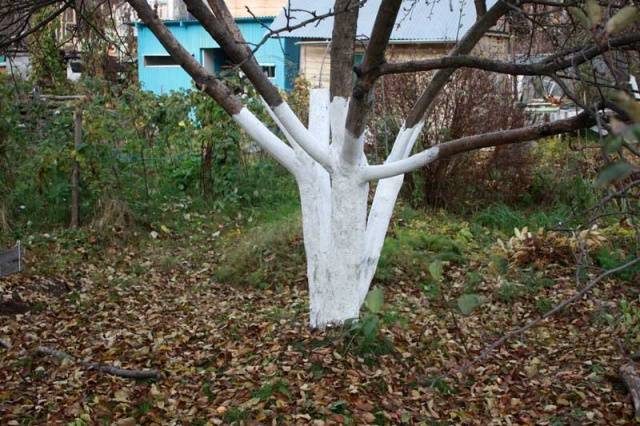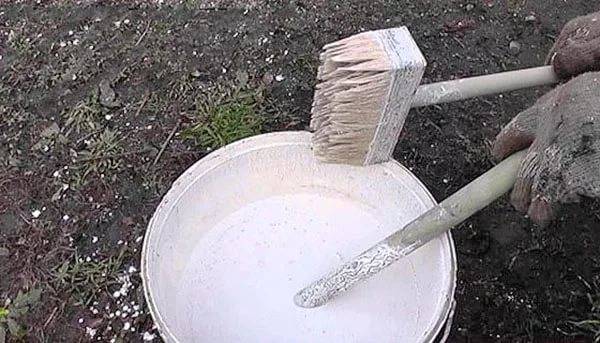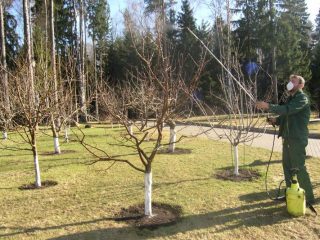Content
Even those who have never dealt with a personal plot know that it is customary to whiten tree trunks in the spring. But not every gardener knows that in addition to spring treatment, it is also necessary to carry out autumn treatment. Whitewashing apple trees in the fall is no less important than in the spring. It has a protective function, protecting tree trunks from hordes of insects and pests, and also protects the bark from sunburn. In order for apple trees to be less susceptible to diseases and bear fruit well, they need help.
Why whiten apple trees in the fall?
Spring whitewashing is a common thing. And everyone knows that trees are treated during this period in order to protect them from the destructive effects of numerous insects and pests. Whitewashing apple trees in the fall has the following goals:
- Protection against fungi and spores of various etiologies;
- Destruction of insect larvae;
- Protection from sunburn;
- Frost protection;
- Protection from small rodents and hares.
In autumn, all insects look for shelter for the winter. Tree bark becomes an excellent shelter for them. Untreated and unprotected apple tree bark is an open gateway not only for insects, but also for infection, fungi and spores.If you do not treat the trees, then, following a decrease in yield, you can expect the rapid death of the fruit tree.
Sudden temperature changes, sudden winter thaws, a large difference between night and day temperatures - it is impossible to predict what else apple trees have to endure over the course of several months of winter. Sunburn is not uncommon. You can get this defeat even in winter, when the bright sun heats the trees. If there are even small dark brown or black areas of bark, then this is where the apple tree will get burned. And white color reflects directly directed rays like a mirror. Thus, in whitened apple trees the risk of damage is reduced significantly.
Many rodents, including hares, are not averse to eating tree bark in winter. And apple trees are no exception in this case. They will be attracted to unprotected trees first.
If you are faced with a rhetorical question: when is it better to bleach apple trees, in the fall or in the spring, the answer will be clear. Fruit trees need protection all year round, which means apple trees need to be bleached at least twice a year.
Preparing fruit trees for winter begins in the second half of September. It is necessary to complete the whitewashing of apple trees before the onset of frost.
Where to begin
Simply applying lime or a bleaching compound to the trunks does not mean that you have fully prepared and whitened the trees for the cold. Immediately before whitewashing apple trees in the fall, it is necessary to carry out a number of preparatory work:
- Barrel cleaning;
- Disinfection;
- Sealing wounds and cracks.
And only after this it will be possible to start whitewashing.All work, including the whitewashing process itself, requires a lot of time and effort. It is advisable to maintain the required time between stages. And all work in the garden must be completed before frost sets in. Therefore, start processing apple trees in advance. Early to mid-October is the ideal time to whiten apple trees in autumn.
Inspection and cleaning of trunks
Every crack on the trunk of an apple tree is, in fact, a breeding ground for all sorts of diseases. To prevent possible infection with scab or fruit rot, the trunks must be inspected and thoroughly cleaned.
For this you will need: a plastic spatula and film or tarpaulin. Iron brushes, spatulas and knives are completely unsuitable for cleaning - they can injure trees. Spread the material around the apple tree to later collect all the cleared debris. It is not advisable to leave it under a tree.
Please note that small pieces of bark may fly off during operation. Therefore, take protective measures: wear special glasses and gloves. Inspect the apple tree for cracks, damage and small holes. All of them need to be carefully cleaned, removing the layer that is easily removed. Remove pieces of moss, lichen, and loose pieces of bark from the trunks.
To clean narrow, hard-to-reach places, use a wooden knife or a thin sliver. When you have completely peeled the apple trees, collect all the bark pieces, even the small ones. You can, of course, simply remove the debris from the garden. But to prevent the spread of pathogenic microorganisms, it is better to burn it.
Disinfection of trunks
After cleaning, the apple tree must be disinfected to destroy all insects.
Disinfection measures must be carried out in dry, windless weather. Pay attention to the weather forecast - precipitation in the next 2-3 days after treatment is undesirable. They will simply wash away all your hard work. Don't forget to take protective measures: wear plastic goggles, a respirator and rubber gloves.
As a disinfectant you can use:
- Bordeaux mixture;
- HOM;
- OXIhom.
Spray the trunk of the apple tree and skeletal branches to a height of 1.5-2 meters from the ground. The composition must be applied in a very thin layer. It is best in this case to use a reinforced sprayer. The main thing is that during processing the disinfectant is evenly applied to the trunks and does not drip down.
Many gardeners use a soap-ash solution to disinfect fruit trees. In addition to the fact that it does not require financial costs, it can rightfully be called universal. Ash perfectly disinfects, and at the same time feeds the apple trees potassium and phosphorus.
To prepare the solution, grate 50 grams of laundry soap on a coarse grater. The water should be very hot, almost boiling water. Add grated soap and ash in an amount of 2.5-3 kg to a bucket of water. Mix the mixture well until the soap is completely dissolved. Let the solution cool.
When the solution has cooled, take a small bundle of hay or unnecessary old rags. Dip into the mixture and apply to the apple bark. In this case, you can not save, but practically wash the trunks with it to the height that your hand reaches.
After treatment, give the trees a short rest.The next stage of work can begin no less than 5-7 days after disinfection.
Sealing cracks and wounds
It is imperative to seal all cracks and wounds on apple trees. They are not only a haven for pests. Through open wounds, pathogenic bacteria and microorganisms quickly penetrate under the bark.
Preparing a mixture for sealing wounds is very easy. You will need clay and manure in a 2:1 ratio and some straw dust. Dilute this mixture with a small amount of water and mix thoroughly. Use a clay mash to carefully cover all wounds, cracks, and damage on the apple trees.
If you don’t have the necessary ingredients on hand, you can use any putty for fruit trees. Specialized stores offer a wide range of these products. RanNet paste has received great recognition among gardeners. They are also perfect for processing open cuts after autumn pruning of apple trees.
After you have repaired all the damage, let it dry thoroughly. It is not recommended to start whitewashing apple trees earlier than 1-1.5 weeks after the putty.
Whitewashing compositions
As was written above, the compositions for whitening apple trees may differ. Why? Each solution performs its function:
- Destruction of insects and their larvae;
- Protection from sunburn;
- Protection from hares and small rodents.
It's up to you to decide which one to use.
Standard composition for whitewashing
The main function of this whitening composition is to destroy insects and protect apple trees from their harmful effects. For kneading you will need: quicklime, clay, water.
The ratio of lime and clay should be 2:1.
First of all, you need to extinguish the lime with water. When the solution has cooled, add clay and knead the composition well. The consistency of the bleaching solution should be like sour cream. Its advantage is that apple tree trunks covered with a sufficiently thick layer will be most protected, and it will not be washed away with the first rain.
If clay is not available, it can be replaced with glue. Casein or wood glue is ideal as an additive for whitening apple trees.
Composition for protecting trunks from burns
This whitening composition has good reflectivity. The sun's rays will not harm your apple trees if they are treated with the following composition:
- Water – 2 liters;
- PVA glue (or stationery) – 2 tbsp. l.;
- Fluffy lime - 300 gr.
If necessary, glue can be replaced with 100 g. milk.
All ingredients must be thoroughly mixed until smooth.
If you add 1 tbsp to this solution. l. DDT powder and 1 tbsp. l. iron or copper sulfate, then the mixture will acquire an additional function. It will protect apple trees from various diseases and fungi.
Rodent control solution
The composition for whitening apple trees prepared according to this recipe is rather universal. Firstly, it destroys pests and their numerous offspring. Secondly, thanks to it, it is possible to carry out timely prevention against putrefactive diseases.
- PVA glue and PVA dispersion in a 1:1 ratio. One serving – 0.5-1 glass.
- Iron or copper sulfate - 2 tbsp. l.
- Water – 2 liters.
With the addition of a few drops of “Knockdown” or a small portion of Creolin, it will protect apple trees from the invasion of small rodents and hares, destroy all fungal spores, as well as ant eggs laid under the bark and in microcracks.
The solution must be mixed thoroughly. Leave it for 20-30 minutes and stir again. Now you can start whitewashing the apple trees.
Whitewashing trunks
To whitewash apple trees, it is important to choose the right brush. It is desirable that the width of the brush is approximately equal to the width of the trunk. In this case, there will be no overconsumption of whitewashing solution, and the work will be completed many times faster. For convenience, you can use a spray gun.
Apple trees need to be whitened correctly, starting from the bottom, gradually moving up. Please note that it is necessary to whiten not only the trunks, but also the skeletal branches to a height of 25-30 cm from the base.
The author of the video will tell you why to whiten apple trees in the fall and how to do it correctly:
Conclusion
All work on cleaning and whitewashing apple trees must be carried out annually in the fall. With regular care, your trees will always be strong and healthy, which will immediately affect the yield and taste of the fruit. Moreover, all of the above measures will significantly extend the life of your trees.























